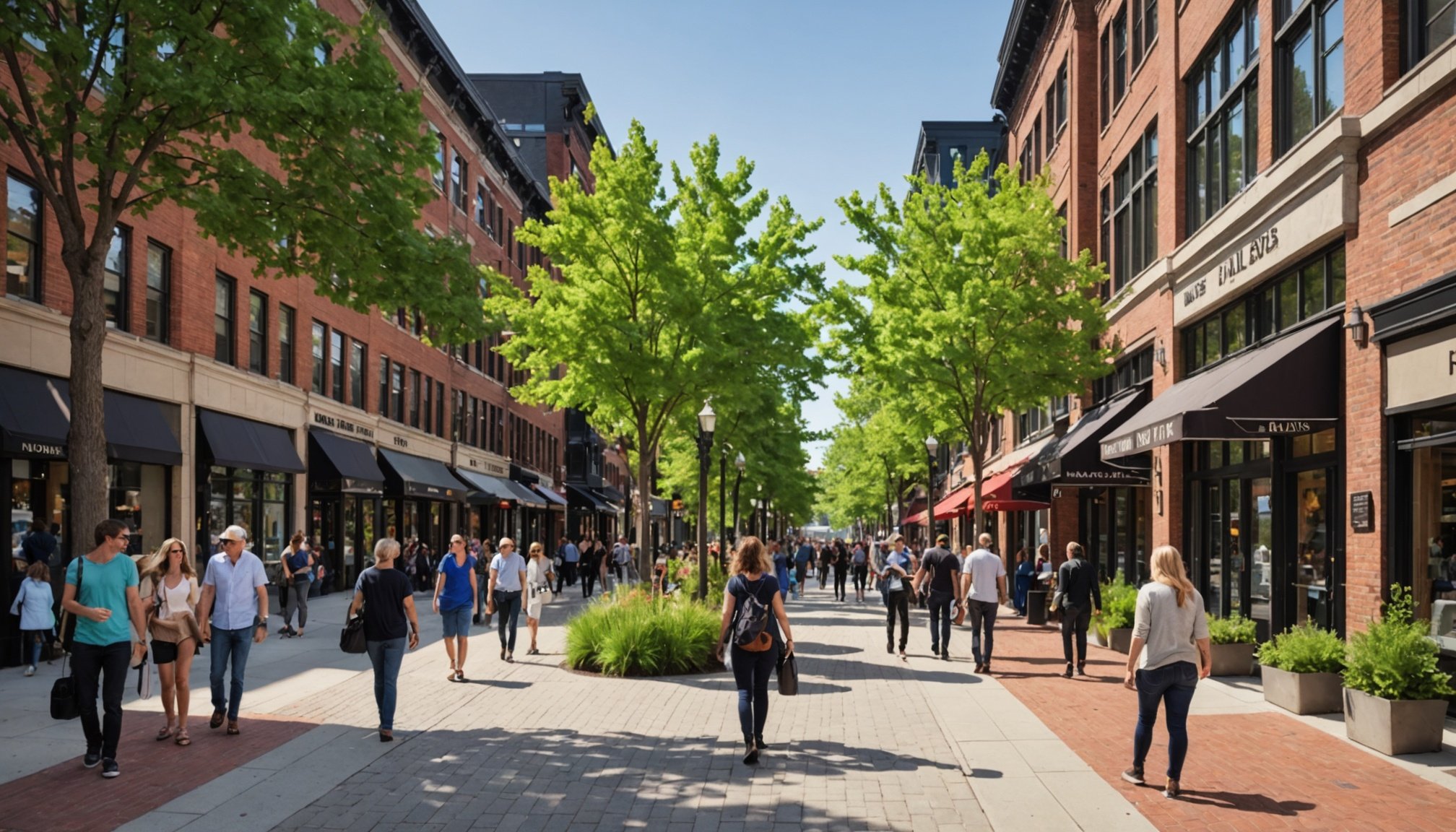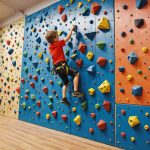Principles of Walkable Design
Creating walkable environments is key to fostering vibrant, sustainable communities. Central to this is the emphasis on design principles that prioritize pedestrian-friendly features. A primary element is accessibility, ensuring that paths and public spaces are welcoming and usable for all individuals, including those with disabilities. Connectivity is equally crucial; it involves designing efficient pedestrian pathways that link key destinations like homes, shops, and parks seamlessly.
The balance between aesthetics and functionality plays a pivotal role. While visually appealing streetscapes attract people, they must be coupled with practical features like adequate lighting, seating, and shade to enhance the pedestrian experience. Incorporating these elements fosters engagement and interaction, creating inviting spaces that people naturally gravitate toward.
In parallel : Harnessing Renewable Energy in Large-Scale Housing Developments: An Ultimate Guide
Safety is another significant factor: well-lit and clearly marked pathways, along with traffic-calming measures, contribute to a secure environment for pedestrians. Environments designed with walkability in mind also encourage healthier lifestyles by promoting physical activity as a part of daily routines. By considering these aspects, urban designers can craft spaces that not only look good but function effectively, encouraging more people to choose walking as a primary mode of transportation. These elements, when integrated thoughtfully, significantly contribute to the creation of lively, pedestrian-friendly communities.
Case Studies of Successful Mixed-Use Communities
Case studies of mixed-use development provide valuable insights into the blend of residential, commercial, and leisure spaces to create vibrant, pedestrian-friendly environments. These examples illustrate how thoughtful design and community engagement can shape functional, appealing, and inclusive communities.
Also read : Unleash innovative techniques to enhance air quality in crowded living environments
Example 1: Urban Case Study
Urban areas often face challenges, such as limited space and high density. A notable case study involves a redevelopment project in a bustling city centre, where old industrial sites were transformed into lively hubs. By incorporating multi-level walkways and accessible elevators, this project enhanced walkability. The presence of diverse retail and dining options at ground level, integrated with upper-floor residential units, fostered interaction and continuous foot traffic, showcasing a seamless blend of urban living and convenience.
Example 2: Suburban Integration
In suburban settings, mixed-use development can address sprawl and isolation. One successful example is a suburban area reshaped into a walkable space through interconnected pedestrian pathways, small parks, and community facilities. Local residents actively participated in planning, ensuring the design principles aligned with their needs. This participation resulted in vibrant spaces where daily necessities, like grocery stores and cafes, are within a short walking distance, reducing reliance on cars.
Example 3: International Perspective
Looking internationally, a community designed in Europe inspired by pedestrian-friendly concepts highlights the integration of historical elements with modern amenities. This development emphasised preserving cultural heritage while adapting urban design strategies to support community vitality, health, and environment. Lessons learned from these case studies demonstrate the importance of tailored solutions and active community development.
Planning Strategies for Walkable Communities
The development of walkable communities hinges on strategic community planning and innovative urban design strategies. It requires a focus on creating smooth, interconnected pedestrian pathways which serve as the backbone of a pedestrian-centric environment. One essential strategy involves designing public spaces conducive to pedestrian traffic. These areas should incorporate elements that not only promote safety, like clear signage and street lighting, but also comfort, such as seating and greenery.
Public spaces play a pivotal role in facilitating pedestrian movement. They act as meeting points and hubs of activity, encouraging social interaction and foot traffic. Cities that integrate seamlessly connected public spaces with accessible pedestrian pathways are more likely to see increased footfall and reduced reliance on automobiles.
- Best practices for effective community planning include collaborating closely with stakeholders at every stage of the process. This collaboration helps to align the vision of urban planners with the needs of the residents. Regular community workshops and feedback sessions can aid this cooperative effort. Furthermore, leveraging stakeholder insights enables the crafting of urban designs that are functional and aesthetically pleasing.
By implementing urban design strategies that consider these factors, planners can create enduring, lively social environments that prioritize the pedestrian experience.
Zoning Laws and Regulations
Zoning laws and regulations are pivotal in shaping land use planning, especially when it comes to developing walkable communities. These laws dictate how land in specific areas can be used, affecting the design principles of urban landscapes significantly.
Understanding Zoning Codes
Zoning codes are fundamental as they determine the type of buildings that can be constructed in different zones, influencing the walkability of areas. For instance, codes can encourage or restrict mixed-use development, impacting how easily residents can access essential services. Understanding these codes allows urban planners to craft strategies that align with community needs.
Innovative Zoning Practices
Innovative zoning practices, such as form-based codes, offer a flexible approach by focusing on building forms rather than conventional land use categories. This can lead to more pedestrian-friendly spaces, promoting a vibrant street life. Examples include creating zones that encourage ground-level retail with residential areas above, supporting seamless integration.
Encouraging Mixed-Use Development
Reforming zoning regulations to encourage mixed-use development is crucial for creating connected communities. By facilitating a blend of residential, commercial, and leisure spaces, zoning reforms contribute to enhanced community development and greater walkability. Case studies show that successful reforms have led to thriving pedestrian zones, reducing reliance on cars while enhancing local economies.
Tips for Integrating Commercial and Residential Spaces
Successfully blending commercial and residential areas hinges on a strategic approach to mixed-use integration. Balancing these two facets demands careful attention to community needs and long-term viability. Here are effective strategies that urban planners can adopt:
-
Multi-functionality: Designing spaces that serve dual purposes encourages interaction between residents and businesses. For instance, incorporating cafe-style workstations or shared community gardens enhances the vibrancy of residential areas.
-
Community Development: Engage local stakeholders in the planning phase to align commercial activities with residential lifestyles. This collaboration fosters spaces that sync with community rhythms, accommodating everything from retail services to local entertainment.
Potential conflicts between bustling commercial areas and tranquil residential zones can arise. Address these by ensuring pedestrian-friendly designs, such as noise-buffering green belts and the strategic positioning of amenities that respect residents’ privacy. Flexibility is key to maintaining inclusivity and receptiveness to diverse community needs.
Case studies have shown the benefits of community development in integrated environments. By prioritizing dialogue and inclusive urban planning, these projects can thrive, creating vibrant, interactive locales that serve both economic and social functions effectively, making them models of successful mixed-use integration.
Visual Aids and Expert Insights
Incorporating visual design is a powerful way to convey innovative urban concepts to both stakeholders and the wider community. By using advanced tools for visualisation, planners can effectively communicate their vision for pedestrian-friendly areas. Tools such as 3D modelling and interactive maps allow for a more immersive experience, bridging the gap between complex design ideas and community understanding.
Tools for Visualizing Design Concepts
A range of technologies aids in the visualisation of urban designs. Digital tools such as CAD software and geographic information systems (GIS) empower urban designers to create detailed and accurate representations of proposed changes. These visuals help in refining concepts, ensuring they align with the community’s needs while expressing the value of walkability.
Perspectives from Urban Design Experts
Insights from urban design experts underscore the significance of visualisation in urban planning. Interviews with these professionals reveal that visual aids not only aid in community feedback but also assist in securing support from policymakers by clearly illustrating the benefits of pedestrian-centric designs.
Community Engagement Methods
Visual tools support meaningful collaboration with the community. Techniques such as participatory mapping and crowdsourced feedback sessions ensure that the community’s voice is integrated into the design process, fostering a sense of ownership and enhancing the success of community development initiatives.
Actionable Steps for Implementation
Implementing pedestrian-friendly initiatives requires a strategic approach that translates careful planning into tangible outcomes. Here’s a step-by-step guide to fostering community projects that enhance walkability.
-
Initial Assessment: Begin with a comprehensive evaluation of the current urban landscape, identifying areas that lack sufficient pedestrian pathways or connectivity. This assessment forms the foundation for targeted interventions.
-
Community Engagement: Integrate community feedback early in the process through workshops and focus groups. This involvement ensures that the implementation strategies are aligned with local needs and context, fostering a sense of ownership among residents.
-
Design Phase: Develop actionable design plans that incorporate clear routes, accessibility features, and aesthetic enhancements. Prioritise walkability by addressing safety measures and ensuring paths are both functional and inviting.
-
Execution Plan: Establish a timeline and allocate resources effectively, collaborating with diverse stakeholders for seamless execution. This phase is critical in transforming plans into reality, requiring vigilance and adaptability to overcome challenges.
Finally, continuously measure success by collecting data on pedestrian usage and satisfaction. Adjust strategies based on findings by integrating community feedback and emerging trends to refine and sustain community projects. This continuous improvement cycle can solidify the long-term success of pedestrian-friendly environments.








